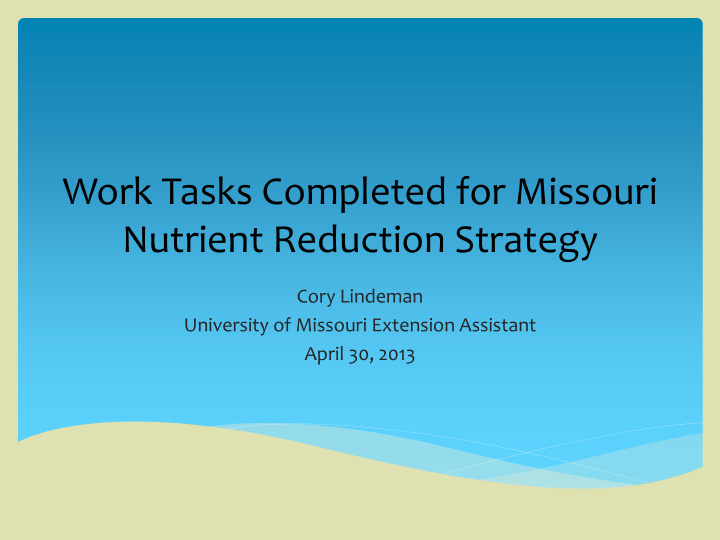



Work Tasks Completed for Missouri Nutrient Reduction Strategy Cory Lindeman University of Missouri Extension Assistant April 30, 2013
Activities Engaged In So far I have had 4 meetings with different affiliates of the Missouri Nutrient Reduction Strategy Committee (Bob Broz, John Lory, Steve Walker, and Colleen Meredith) Established a path of research to take in order to complete the Missouri nutrient reduction strategy BMP research Use of Extension resources Point-source pollution work tasks
Areas of Research Gulf of Mexico hypoxia Iowa nutrient reduction strategy Cost-share programs Watershed targeting Agricultural BMPs to use within Missouri Nutrient Management
Point Source Pollution Work Tasks Compiled a list of Missouri industrial and municipal facilities with NPDES permits exceeding a daily effluent of 22,500 gallons/day Phosphate laundry and dishwashing detergent federal/state laws Municipal biosolids land application federal/state laws
BMPs researched thus far for NPSP Cover crops End-of-season corn stalk nitrate test Variable rate nitrogen application Setbacks Riparian Forest Buffers Vegetative Filter Strips Conservation/No-tillage management systems
Information included in BMP summaries Title Develop a clear description of the conservation practice Evaluate the status of technical assistance and educational materials available for use in Missouri Define the key potential benefits and barriers or unintended consequences of adopting the practice Evaluate the effort needed to develop an estimate of effectiveness and economic impact on Missouri farmers
Example of BMP Summary Variable rate N application Soil properties, such as N availability, fluctuate in each field for various reasons, leading to different rates of optimal N required for optimal yields. Common Missouri fertilizer management includes using a set amount of N to reach optimal yields from year-to-year. This practice leads to varying yields due to soil properties. The practice of variable rate N application helps compensate for this unknown by applying N according to color of corn plant. Research has proven corn color to be most accurate indicator of N deficiencies. Reflectance sensors have become an integral part of smart N management for farmers. As the sensors are deployed on fertilizer equipment, computers read sensor output and control variable rate of fertilizer needed to achieve operational yield goals. A high N reference area is needed in each field to calibrate the sensors for the growth stage plants are in. Establishment of a high N reference area should be a representative location and N should be applied during ideal time. If the establishment of high N reference area is too early/late or a major precipitation event occurs afterwards, the area could through off sensors allowing less/more N to be used than needed. When applying fertilizer at variable rates, the high N reference area should be gone over at least every two hours to keep sensors calibrated correctly. The development of reflectance sensors has led to the ability to apply nitrogen at optimal rates for a specific area of corn crops. Optimal fertilization can lead to savings for a farm by using appropriate amount of fertilizer and cutting out excess applications. Variable rate N application might not lead to increased yields for an operation, but it is possible for the farm to see savings in their fertilizer purchases. With increasing focus on agricultural practices becoming more environmentally sustainable, variable rate N application would help prevent excess N being present and in danger of leaching or denitrification, to limit N loss. Use of only required fertilizer to achieve yield goals can have many positive environmental effects. Issues with variable rate N application include the limited adoption of the practice. To achieve variable rate applications, one must purchase the sensors and controllers used within the operation. Proper training is required to program computers for use and to make ideal use of man hours required for set-up. Extension outreach could include training sessions for set-up and control of computers for selected sensors to make farmers more acquainted with common practices associated with variable rate applications. Also each sensor’s output needs to be calculated in terms of N fertilizer output to keep the system using optimal amounts of fertilizer. Calculations for sensors are ever-evolving during use because of the changing variables such as moisture on plant surface, time of day, growth stage of plant, type of corn plant. Long-term effectiveness should be studied in terms of extended period of droughts to determine what calculations will work best with extreme weather events common in Missouri.
Winter Cover Crop Species Selection for Missouri Species Crop Class Winter Hardiness Dry Matter (lbs./A/yr) winter rye NL Statewide 3000-10000 hairy vetch L Statewide 2300-5000 red clover L Statewide 2000-5000 crimson clover L S. Missouri 3500-5500 sweet clover L Statewide 3000-5000 spring oats NL NFT 2000-10000 oilseed/tillage radish NL NFT 4000-7000 turnip NL NFT 3000-6000 alfalfa L Statewide 4000-8000 winter wheat NL Statewide 3000-8000 buckwheat NL NFT 2000-4000 black medic L NFT 1500-4000 field peas L NFT 4000-5000 triticale NL Statewide 3000-10000 L=Legume NFT=Not Frost Tolerant NL=non-legume
Questions?
Recommend
More recommend